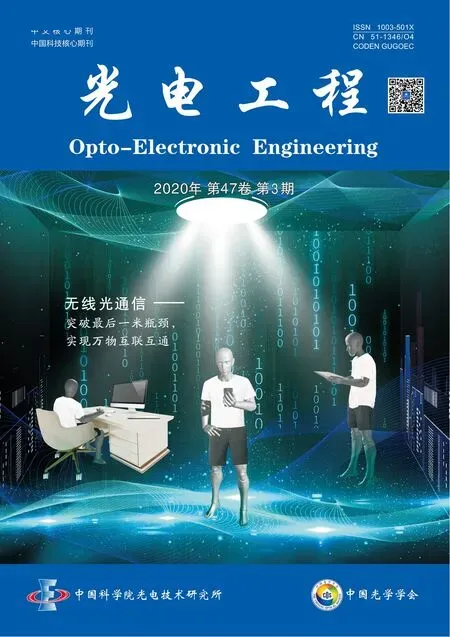逆向调制无线光通信空间分集分析
王 珂,徐智勇*,李雪松,汪井源,李建华,赵继勇,韦毅梅,吴传信
逆向调制无线光通信空间分集分析
王 珂1,徐智勇1*,李雪松2,汪井源1,李建华1,赵继勇1,韦毅梅1,吴传信1
1陆军工程大学通信工程学院,江苏 南京 210007;2战略支援部队信息通信工程设计所,辽宁 沈阳 100005
在逆向调制无线光通信系统中,大气湍流对系统的影响大于传统的无线光通信系统。本文研究了一种基于逆向端调制器分集的逆向调制无线光通信系统,以减小大气湍流对系统的影响。利用相位屏法,建立了弱湍流下的激光大气的传输模型,对比分析了逆向调制无线光通信系统逆向端逆向调制器分集和不分集分别所受到的大气湍流的影响。结果显示在相同情况下,逆向调制无线光通信系统在逆向端对逆向调制器进行分集能抑制大气湍流对系统的影响,使整个系统的闪烁指数下降。
光通信;逆向调制;大气湍流;分集;闪烁指数
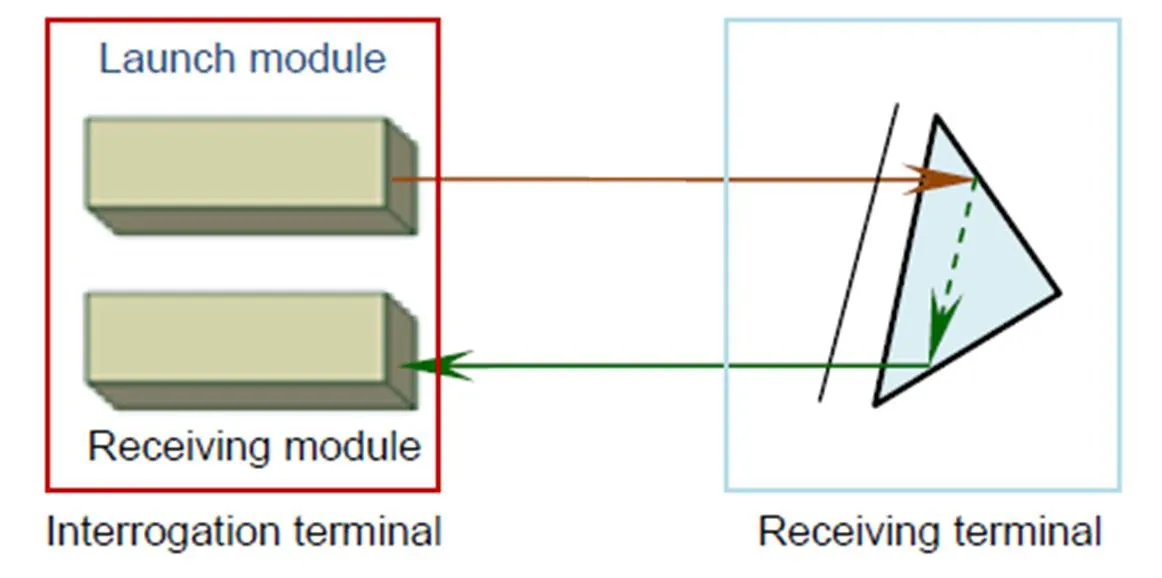
1 引 言
自由空间光通信是利用激光在真空或大气中传输信息的无线通信方式[1]。它具有大容量、高性能、良好的隐蔽性、较强的抗干扰性以及无需频谱许可证等优点。在自由空间光通信系统中,为了简化点对点通信设备,研究人员提出了一种只需要在一端安装光源的光通信系统——逆向调制无线光通信系统[2-4]。逆向调制无线光通信系统如图1所示,可以分为三个部分:询问端、逆向端和大气信道。其中询问端包括光发射机和光接收器,逆向端为逆向调制器。
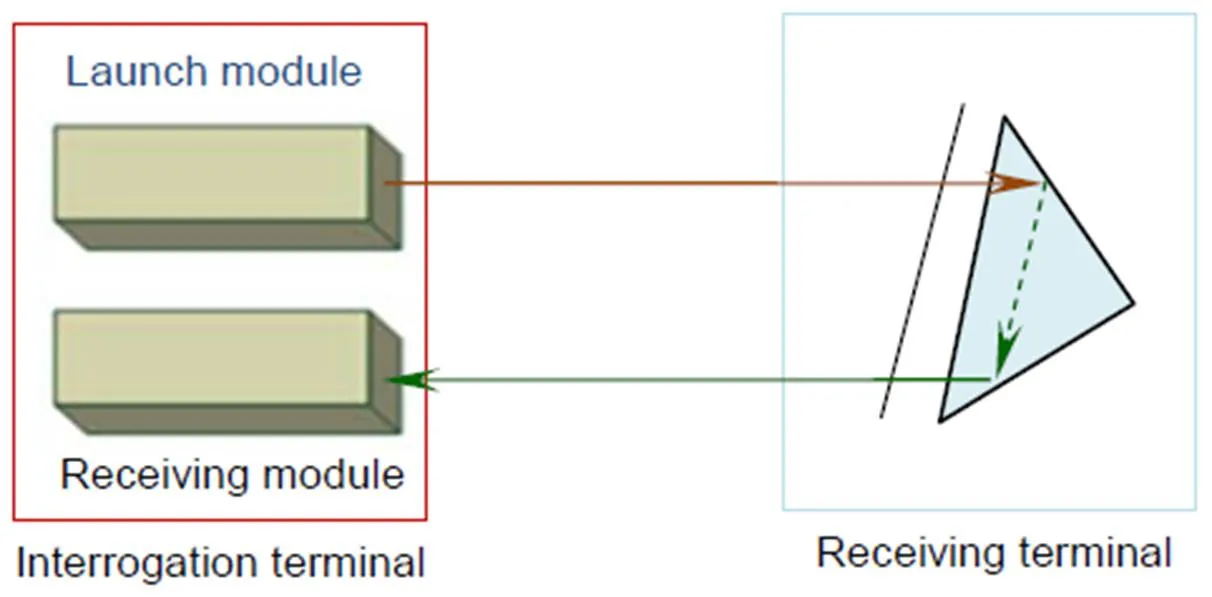
图1 逆向调制无线光通信系统
在拥有众多优点的同时,逆向调制无线光通信技术也具有一定的局限性,大气的影响是制约该技术通信速率的主要因素之一。在大气影响中,湍流的影响是其中最重要的影响之一,它主要导致大气折射率的随机变化,增加了系统的误码率。
为了克服大气湍流对逆向调制无线光通信系统的影响,近年国内外进行了一系列相关研究。2011年,美国学者提出了一种基于弱湍流的自由空间光通信评估方法,可以模拟自由空间光通信中各种参数对大气湍流闪烁指数的影响[5]。2012年,美国海军实验室在加利福尼亚的中国湖进行了一系列实验,连续四天测试和分析了1.1 km逆向调制无线光通信系统,研究了各种因素对逆向调制无线光通信系统的影响[6]。2014年,华盛顿特区的美国海军实验室使用了分集和孔径平均等技术进行距离为1.7 km的实验,使得大气湍流造成的光强闪烁明显减少[7]。2012年电子科技大学对猫眼结构的逆向调制器进行了实验和性能分析[8]。2015年重庆大学提出了一种基于声光调制的逆向调制光通信系统[9]。2019年陆军工程大学对利用孔径平均效应减少大气湍流对系统影响进行了仿真和实验验证[10],同年杭州电子科技大学利用大气湍流模拟箱搭建了实验系统进行了功能验证和性能分析[11]。目前,国内外对于逆向调制光通信的研究较多,但是对于系统大气湍流抑制的研究较少,缺乏深入的理论分析和实验研究。本文通过建立高斯光束在弱湍流下的传播模型,研究了大气湍流的影响下逆向端的几种分集方式并对其进行了比较,通过比较得出了逆向端逆向调制器孔径大小和距离的相关结论,为逆向调制无线光通信系统的设计提供了参考。
2 系统模型
2.1 模拟的组成
图2给出了逆向调制(modulating retro-reflector,MRR)无线光通信系统的理论结构,主要包括三个部分:询问端、大气信道、逆向端。考虑到光的传播速度,默认了激光往返两次的大气信道不会改变,所以整个系统仿真主要由上述三个部分组成。

图2 逆向调制无线光通信系统仿真流程图
2.2 相位屏法的原理
如图3所示,仿真建模采用的是相位屏法,其基本思想是使距离为大气通道分成若干个距离为Δ的部分。每个部分等价于一个薄的相位屏。最后结果相当于多个相位屏的叠加,最终的数学表达式如下[5]:


其中:(,L)为L点的光场,(,L1)为L+1的光场,(,L+1)为该分段的随机相位。
2.3 设定参数

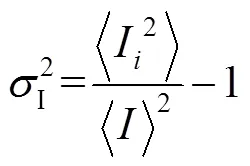

3 湍流效应的分析
为了研究逆向端的分集方法,本文研究了不同模型、不同距离、不同孔径下逆向调制无线光通信系统的闪烁指数。
3.1 空间多样性方法的模型比较
改变逆向端调制器的结构,如图4所示,总共进行了500次模拟,并取了平均值。结果如图5所示。
在1000 m的传播距离内,闪烁指数随着距离的增加而不断增加。大口径逆向调制器闪烁指数最小,其次是环形逆向调制器,其余几个方案随着小口径逆向调制器数目的增加,闪烁指数减小。当小口径逆向调制器数目为4时,闪烁指数与环形逆向调制器接近。
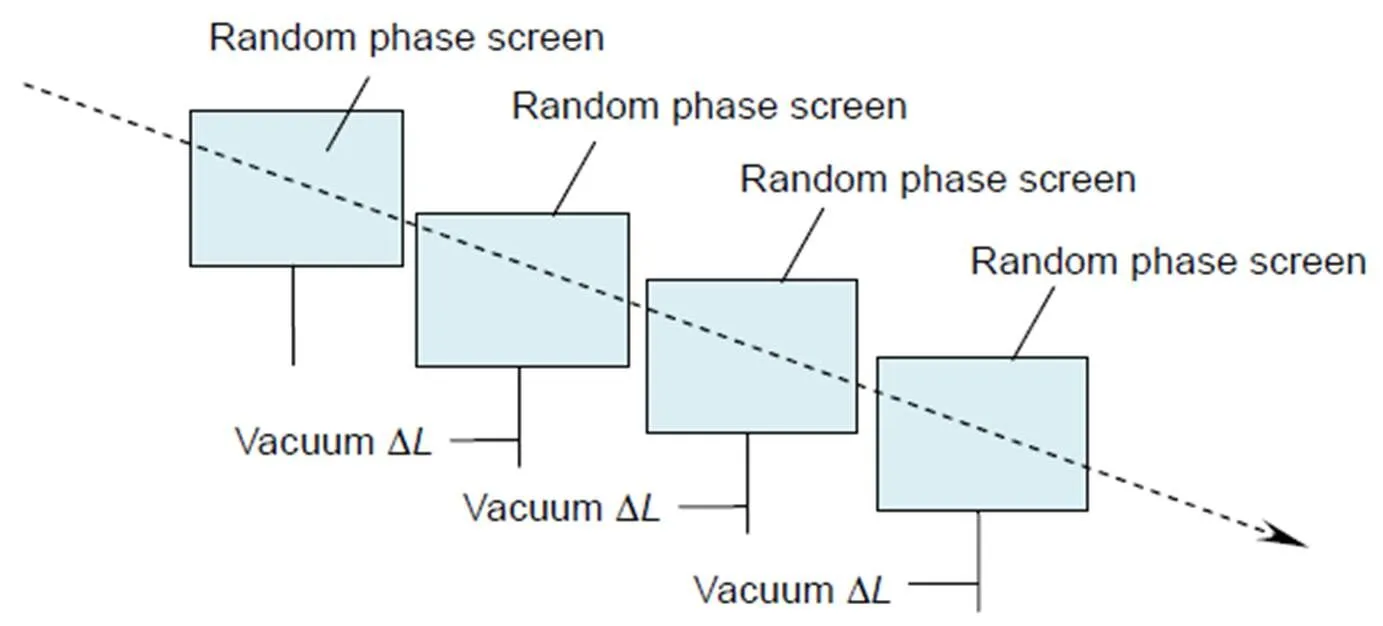
图3 相位屏建模原理图
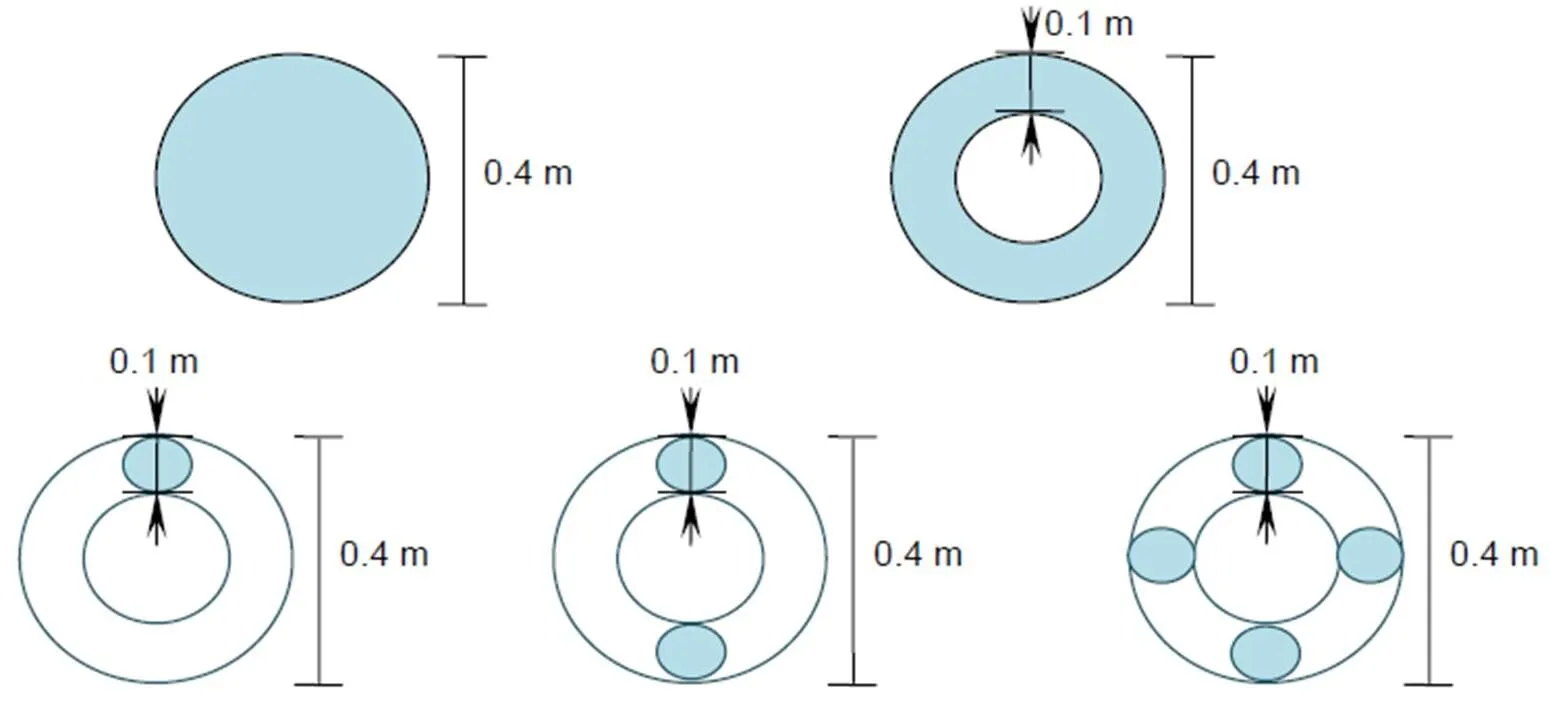
图4 逆向端分集示意图
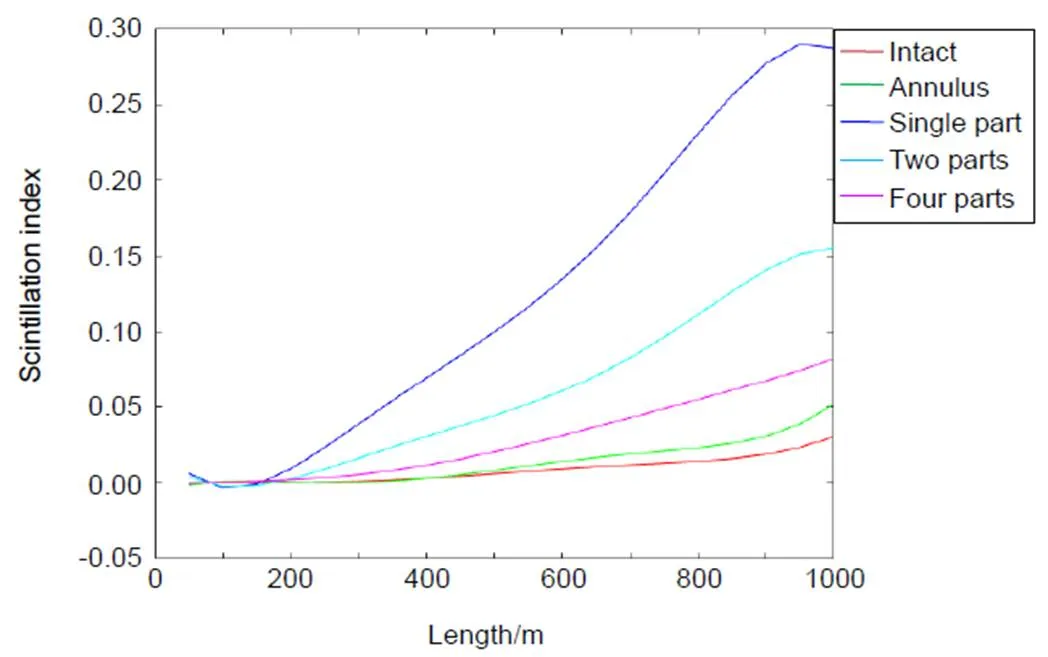
图5 逆向端分集闪烁指数对比图
3.2 空间分集法的距离比较
在逆向端,逆向调制器之间的距离也将影响最终的闪烁指数。在本模拟研究中,大气折射率常数为5×10-15,逆向调制器数目恒定为4,逆向调制器孔径恒定为0.05 m,通过调节逆向调制器之间的距离,分析闪烁指数的变化。在模拟仿真中,逆向调制器之间的距离分别调节为0.15 m、0.2 m和0.25 m,进行500次模拟后得到数值分析结果如图6所示。
图6为逆向调制器孔径0.05 m的情况下,闪烁指数随着传输距离的增加而增大。继续比较不同逆向调制器距离的数据,可以发现闪烁指数随着逆向调制器之间距离的增加而不断减小。通过仿真可以看出,在逆向调制器数目恒定为4,逆向调制器孔径恒定0.05 m的情况下,增加逆向调制器之间的距离可以降低闪烁指数。
3.3 空间分集的孔径比较
在逆向端,逆向调制器的孔径也将影响闪烁指数的大小。在本模拟研究中,大气折射率常数为5×10-15,逆向调制器数目恒定为4,逆向调制器间的距离恒定为0.2 m,通过调整逆向调制器的孔径大小,分析闪烁指数的变化。在模拟仿真中,逆向调制器的天线口径分别调整为0.03 m、0.04 m和0.05 m,进行500次模拟后得到数值分析结果如图7所示。
图7在逆向调制器间距离固定的情况下,可以发现系统的闪烁指数随着孔径的增大而减小。通过仿真可以得出在逆向调制器数目恒定为4,逆向调制器间距离恒定为0.2 m的情况下,增加逆向调制器的孔径也可以降低系统的闪烁指数。
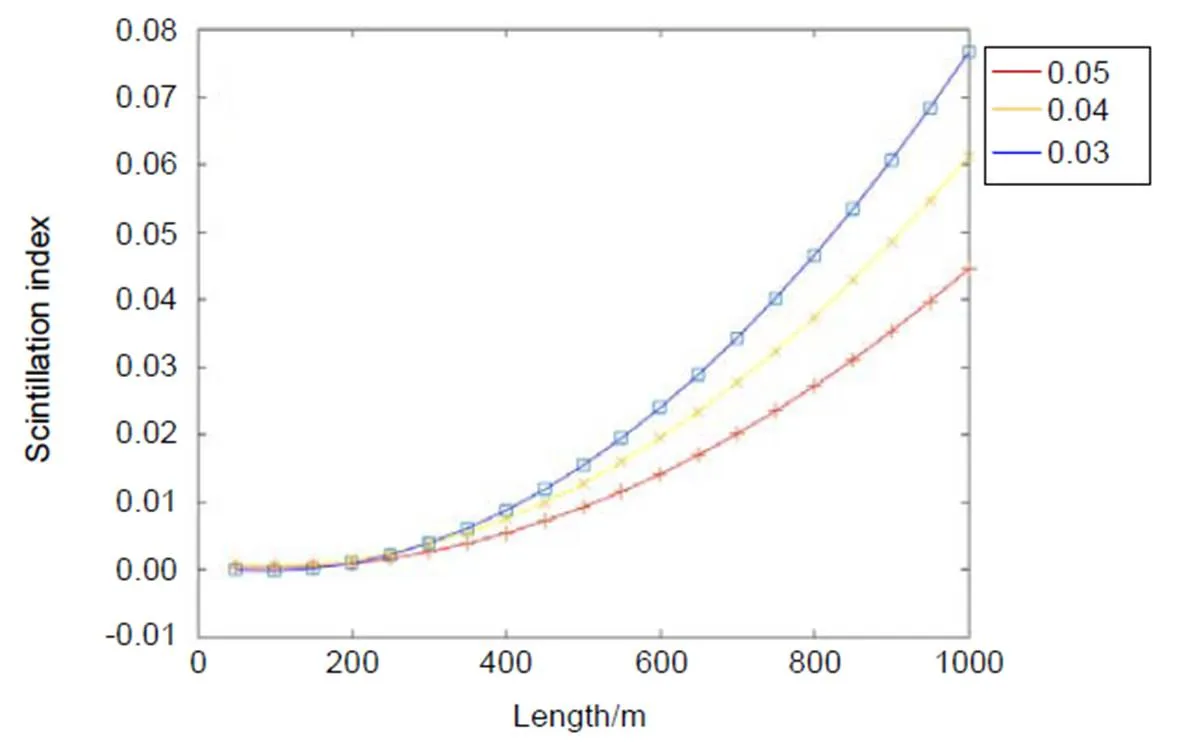
图6 不同距离逆向端分集闪烁指数对比图

图7 不同孔径逆向端分集闪烁指数对比图
4 结 论
逆向调制无线光通信作为一种新型的通信方式,具有体积小、重量轻、能耗小等众多优点,但是相对于传统自由空间光通信,增加了回波反射链路,经历了往返两次大气信道,受到的大气湍流影响更加严重,闪烁指数也更大。在本文中,通过数值分析的方法研究了逆向调制无线光通信中逆向调制端的空间分集。结果表明,在逆向调制无线光通信中,对逆向端的逆向调制器分集可以有效地降低整个链路的闪烁指数,在使用4个逆向调制器的情况下,保持其他变量不变,增加天线之间的距离或者增大逆向调制器孔径都可以降低系统的闪烁指数。
[1] Chen Z X. Research on scintillation supression techniques for free-space optical communications[D]. Beijing: Beijing University of Posts and Telecommunications, 2013.
陈志晓. 自由空间光通信中光强闪烁抑制的研究[D]. 北京: 北京邮电大学, 2013.
[2] Ren J Y, Sun H Y, Zhang L X. Free space optical communication technology based on cat-eye modulating retro-reflector[J]., 2017, 47(1): 98–102.
任建迎, 孙华燕, 张来线. “猫眼”逆向调制自由空间光通信技术[J]. 激光与红外, 2017, 47(1): 98–102.
[3] Zhang Z Y, Wang J Y, Xu Z Y,. Modulating retro-reflector communication system based on speckle detection[J]., 2017, 46(12): 1206003.
张忠玉, 汪井源, 徐智勇, 等. 基于散斑检测的逆向调制光通信[J]. 光子学报, 2017, 46(12): 1206003.
[4] Qiu H, Wang J Y, Xu Z Y,. Modulating retro-reflector optical communication technology[J]., 2015, 39(2): 29–33.
邱灏, 汪井源, 徐智勇, 等. 逆向调制光通信技术[J]. 军事通信技术, 2015, 36(2): 29–33.
[5] Avlonitis N, Charlesworth P B. Performance of retro reflector-modulated links under weak turbulence[J]., 2012, 6(6): 290–297.
[6] Mahon R, Moore C I, Ferraro M,. Atmospheric turbulence effects measured along horizontal-path optical retro-reflector links[J]., 2012, 51(25): 6147–6158.
[7] Rabinovich W S, Mahon R, Ferraro M,. Reduction of scintillation in optical modulating retro-reflector links[J]., 2014, 22(23): 28553–28565.
[8] 魏宾. 基于声换能器的“猫眼”逆向光调制技术及应用[D]. 成都: 电子科技大学, 2012.
[9] Xu S H, Xiao S L, Wang S,. Research on modulating retro-reflector technology of laser communication systems based on acousto-optic modulation[J]., 2015, 39(5): 598–602.
徐山河, 肖沙里, 王珊, 等. 基于声光调制的逆向调制光通信系统研究[J]. 激光技术, 2015, 39(5): 598–602.
[10] Pan L, Wang J Y, Xu Z Y,. Effect of the atmospheric turbulence and aperture mean on modulating retro-reflector optical communication[J]., 2019, 40(1): 140–144.
潘璐, 汪井源, 徐智勇, 等. 逆向调制光通信的大气湍流及孔径平均效应[J]. 半导体光电, 2019, 40(1): 140–144.
[11] Li C Y. Research on modulated retro-reflective free space optical communication system[D]. Hangzhou: Hangzhou Dianzi University, 2019.
李长盈. 调制回复反射自由空间光通信系统的研究[D]. 杭州: 杭州电子科技大学, 2019.
[12] Wang H Q, Li Y, Hu Q,. Experimental investigation on light intensity fluctuation at night in Lanzhou area[J]., 2018, 47(4): 0401001.
王惠琴, 李源, 胡秋, 等. 兰州地区夜间光强起伏特性实验[J]. 光子学报, 2018, 47(4): 0401001.
[13] Bian Y C. The research on atmosphere influence of space optical communication[D]. Changchun: Changchun University of Science and Technology, 2007.
边永昌. 大气对空间光通信影响研究[D]. 长春: 长春理工大学, 2007.
Analysis of space diversity method in modulating retro-reflector optical communication
Wang Ke1, Xu Zhiyong1*, Li Xuesong2, Wang Jingyuan1, Li Jianhua1, Zhao Jiyong1, Wei Yimei1, Wu Chuanxin1
1Institute of Communications Engineering, Army Engineering University of PLA, Jiangsu, Nanjing 210014, China;2Institute of Information and Communication Engineering, Strategic Support Force, Shenyang, Liaoning 100005, China
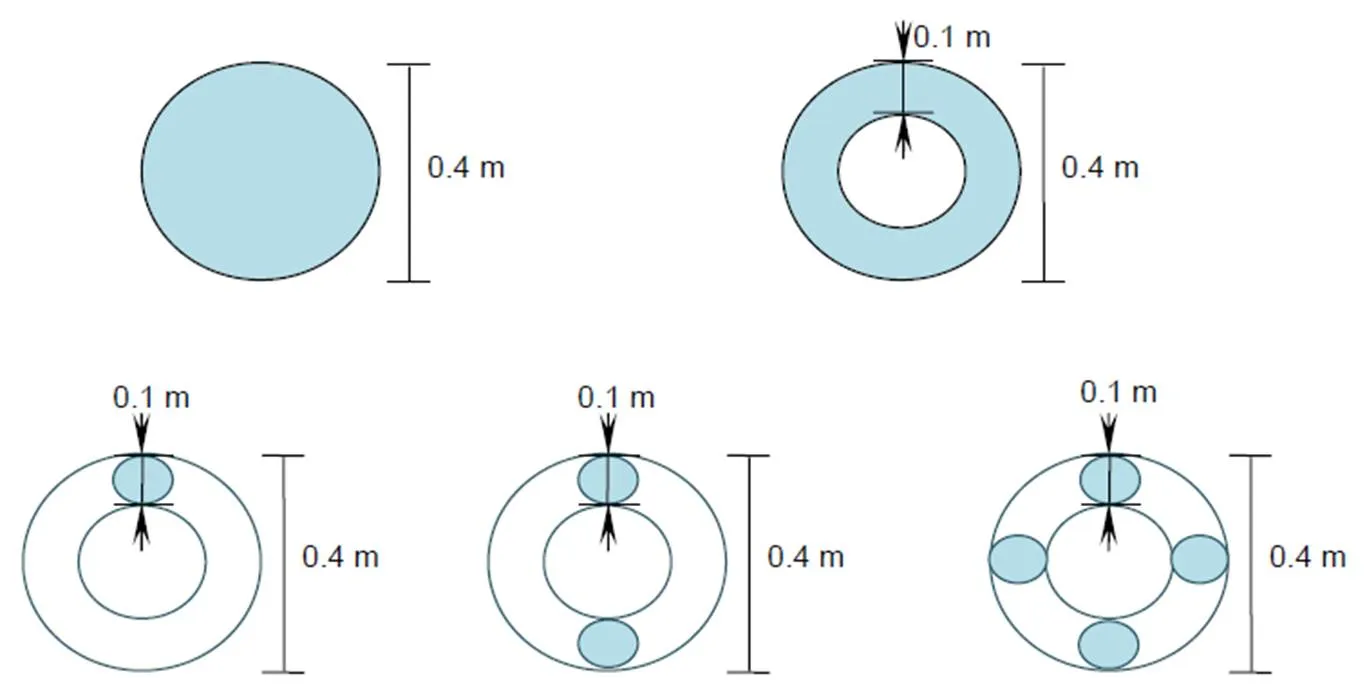
Schematic diagram of space diversity method
Overview:Free space optical communications (FSO) has become a hot research topic in the field of optical communications. Compared with the traditional optical fiber communication, the main characteristic of wireless optical communication is to get rid of the optical fiber signal, which can be used in some special occasions. Generally speaking, the advantages of FSO are as follows: the frequency of the optical signal is high enough to avoid interference by the surrounding electromagnetic waves; Enough capacity to transmit at speeds up to a gigabit per second; It has a separate communication band and does not occupy the existing band. The traditional FSO needs to load the laser transmitting/receiving system at both ends, and the complex tracking system needs to be built, which increases the weight, volume, power consumption and technical complexity of the system. Thus they become an important factor restricting the application of FSO. The modulating retro-reflector (MRR) system can eliminate the laser transmitter and the tracking system of a terminal in the communication link. As a consequence; it greatly reduces the weight, volume and power consumption of one end of the link and effectively solves the application limitation of FSO. However, the MRR system is more vulnerable to the atmospheric turbulence than the FSO system. Although so far, there are many literatures on efficiently reducing the atmospheric turbulence, most of them are based on the traditional FSO communication system. In this paper, we build the MRR laser atmospheric propagation model under weak turbulence by using the power spectrum inversion method. Scintillation index is a physical quantity describing the degree of turbulence in the atmosphere. The numerical analyses show that under the same condition and for the diversity of the reverse modulation echo reflection link at a propagation distance of 1000 m, the scintillation index increases continuously as the distance increases, and decreases as the number of sub-sets increases. When the number of modulators is four, the scintillation index is similar to that of the ring-shaped reverse modulator. The more diverse is, the greater the cost is. Therefore, within a kilometer range, it is an ideal solution to select four inverse modulators. With simulation of the four parts diversity model, it is found that with the increase of the distance between antennas, the amplitude of the scintillation index decreases. It is also suggested that increasing the aperture of the reverse-end-modulated end-diversity antenna can also reduce the system scintillation index.
Citation: Wang K, Xu Z Y, Li X S,Analysis of space diversity method in modulating retro-reflector optical communication[J]., 2020, 47(3): 190701
Analysis of space diversity method in modulating retro-reflector optical communication
Wang Ke1, Xu Zhiyong1*, Li Xuesong2, Wang Jingyuan1, Li Jianhua1, Zhao Jiyong1, Wei Yimei1, Wu Chuanxin1
1Institute of Communications Engineering, Army Engineering University of PLA, Jiangsu, Nanjing 210007, China;2Institute of Information and Communication Engineering, Strategic Support Force, Shenyang, Liaoning 100005, China
In the modulating retro-reflector (MRR) communication system, the influence of the atmospheric turbulence on the system is more serious than that of the traditional FSO communication system. In this paper, in order to reduce the impact of the atmospheric turbulence, an improved scheme based on the diversity of the retro-reflector is proposed. Using the power spectrum inversion method, the atmospheric propagation model of MRR under weak turbulence is established. The influence of the atmospheric turbulence on the retro-reflector diversity system and the traditional MRR communication system is compared and analyzed. The results of the numerical analysis show that under the same condition, the retro-reflector diversity of modulating retro-reflector (MRR) communication system can reduce the scintillation index caused by the atmospheric turbulence.
optical communication; modulating retro-reflector; atmospheric turbulence; retro-reflector diversity;scintillation index
TN929.1;E963
A
10.12086/oee.2020.190701
: Wang K, Xu Z Y, Li X S,. Analysis of space diversity method in modulating retro-reflector optical communication[J]., 2020,47(3): 190701
2019-11-21;
2020-02-14
江苏省光通信工程技术研究中心基金资助项目(ZXF201901)
王珂(1990-),男,硕士研究生,主要从事无线光通信的研究。E-mail:1044620855@qq.com
徐智勇(1972-),男,博士,教授,主要从事无线光通信的研究。E-mail:13914753638@163.com
王珂,徐智勇,李雪松,等. 逆向调制无线光通信空间分集分析[J]. 光电工程,2020,47(3): 190701
Supported by Research Center of Optical Communications Engineering & Technology, Jiangsu Province (ZXF201901)
* E-mail: 13914753638@163.com

